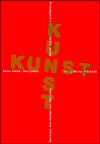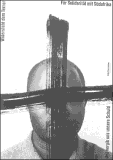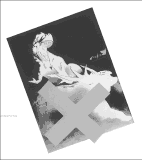Rene Wanner's Poster Page
BOOK REVIEW
 Ueberkreuz. Vom Zeichen zum Abzeichen Plakate, Buchkunst, Grafik, Werbung
Ueberkreuz. Vom Zeichen zum Abzeichen Plakate, Buchkunst, Grafik, Werbung
Stefan Soltek + Uwe Loesch; Verlag Hermann Schmidt, Mainz (D) (1998); published
on the occasion of an exhibition at the Museum fuer Kunsthandwerk, Frankfurt/M (D);
200 pages, about 100 b/w, some color reproductions; 33 x 24 cm, hardcover; ISBN 3-87439-467-0;
DEM 68.00 (about 44 US$); in german
The nice saleslady from the Hermann Schmidt Verlag was beaming with excitement
when she explained the key feature of their new book : "If you would take
a power drill and would drill a hole through the cover, right through the book, it
would pass through the center of a cross on each page". The book title
on the dust jacket forms a sort of cross hairs to guide the inexperienced
book driller on where exactly to start. All the pictures in the book show
crosses in various forms and shapes, and are cleverly positioned so that the center
of the cross is always at the center of the page. Wow!
That's an idea worthy of graphic designer Uwe Loesch I thought, and indeed, he is a co-author,
together with Stefan Soltek, curator of an exhibition on crosses at the Frankfurt Museum
fuer Kunsthandwerk, a Loesch fan and frequent contributor to the german graphic design
publication Novum.
Dr. Soltek and Prof. Loesch have searched the poster and rare book collection of the museum for pictures
of crosses and have come up with a dazzling array of them: A pierced nipple with
a dangling cross, swastikas, ass holes, a drawing by Soltek's daughter when her hamster died,
Keith Haring's penis with a cross painted on it, and about 50 posters made by graphic
masters ranging from Makoto Saito, Rosmarie Tissi, Niklaus Stoecklin to John Heartfield,
Niklaus Troxler, Josef Mueller-Brockmann and Shin Matsunaga, to name a few, all
reproduced in muddy black and white illustrations. Also a couple of
Loesch's, of course. The authors proudly note the absence of cross stitches, graveyards
and spaghetti junctions in their selection as not meeting their high standards of relevance.
Why not spaghetti junctions? Never mind.
The introduction to the book is written by xxx (who else ?), and entitled Luja,
presumably a famous bavarian last word. There is no table of content, but if you have
the stamina to dig through 24 pages of continuous unformated text printed in light gray,
fortified by 79 footnotes printed across the same text in
font size 4 , you might
catch the beginning of an article by Lucas Wuethrich on the history of the swiss flag, and will enjoy the numerous
untranslated latin quotes for relaxation. By that time, the absence of an index of
keywords or poster designers or illustrations will hardly bother you.
Nevertheless, the temptation to actually read the book is great, because of the
fascinating topic and the rich material that is presented.
I even tried to look up the various crosses which are discussed at length in the text,
but had to give up because most are hidden on half size pages
dispersed randomly throughout the book and no typographic help is offered to establish
a correspondence between word an image.

Resist terror. For solidarity with South Africa
1985
Uwe Loesch
|

Uwe Loesch fuer Mouvement de la Paix Paris
1989
Uwe Loesch
|

transit. Bruegge - Novgorod
exhibition poster for Ruhrlandmuseum Essen, Duesseldorf
1997
Uwe Loesch
|

layout of page 96
main text printed vertically in light gray , overprinted with horizontal footnotes
|
Need I say more ? Yes. This is not a book, but a piece of art. There is a stamp in
golden ink (smelling faintly like Beuys) on the cover, on the first and on the
last page, to prove it, even a picture of the rubber stamp. If you trust your
judgment about the investment value of art, you might consider buying it.
home other reviews
page created on March 19, 1999 / this section is part of Rene Wanner's Poster Page
/
 Ueberkreuz. Vom Zeichen zum Abzeichen Plakate, Buchkunst, Grafik, Werbung
Ueberkreuz. Vom Zeichen zum Abzeichen Plakate, Buchkunst, Grafik, Werbung



